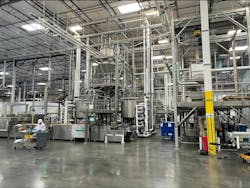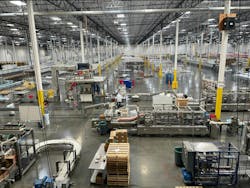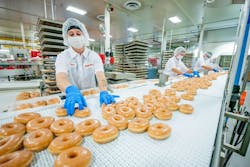The baking industry appears ready to pounce in 2024 — at least based on the new plant openings and plans for new construction that have hit the headlines recently. The question is, will consumers give them a reason to do so?
According to the most recent data available from Circana and the International Dairy-Deli-Bakery Assn., for the 52 weeks ending Jan. 28, dollar sales in total bakery were up 5.7% from the prior year to $43.5 billion. However, unit sales went down 1.7% over the prior year, a disappointing development. Yet, the report offered a silver lining, saying unit sales “are starting to recover” based on the numbers for January 2024 alone.
There’s also optimism implied by J.M. Smucker Co.’s blockbuster acquisition of Hostess Brands in 2023, a $5.6 billion transaction that closed in November and was expected to create significant distribution opportunities for both companies’ legacy brands.
Additionally, comments made by Flowers Foods CFO Steve Kinsey during a company presentation at Bank of America’s 2024 Consumer & Retail Conference should help the industry feel a little better about the marketplace. When asked about the Tastykake brand’s future (in relation to the Hostess acquisition), Kinsey said cake still had a place in the company’s portfolio, and Flowers Foods was looking for opportunities to build more brand relevance.
Finally, flour-milling and ingredient company Ardent Mills surveyed 10,000 U.S. consumers and found that “rewarding and treating” was a top dietary priority for 68% of respondents, and 63% reported eating store- or restaurant-bought sweet baked goods a few times a month or more often.
Processing positivity
Despite these imperfect results, there are signs of cautious optimism. Numerous processors appear to have positioned themselves for a bounceback in 2024 and beyond, with acquisitions, expansions and announcements of new facilities making headlines.
King’s Hawaiian, Bakery Express Midwest, Nature’s Bakery and Hope Baking Co. were among the companies announcing new construction projects in the past six months, while companies like Aspire Bakeries and Mary’s Gone Crackers have already finished expansions and new facilities.
Aspire’s Hazelton, Pa., facility recently completed an expansion that drove the plant’s footprint to 113,000 sq. ft. Beau Netzer, chief commercial officer of foodservice for Aspire, said the bakery “will have the capacity to produce multiple sizes, formats and configurations” of Pennant puff pastry products, as well as custom-baked goods.
Some of the new plant projects on tap aren’t tiny endeavors, either. Irresistible Foods Group (parent company of King’s Hawaiian) will invest $200 million on a greenfield facility in Taylorsville, Ind., while Mars (Nature’s Bakery’s parent) is building a $237 million plant in Salt Lake City, Utah.
Reno, Nev.-based Mary’s Gone Crackers, which manufactures organic, gluten-free crackers and cookies, recently doubled its production capacity at its plant, and CEO Michael Finete says the company will continue to push the envelope.
“With us, it’s kind of ingrained in our DNA that this is the way to do it: It’s how do you do something and how fast can we produce something better?” he explains. “It just takes the commitment, and we’re always challenging our product asking if there’s a better way, or a way to enhance it.”
Mary’s Gone Crackers is a subsidiary of Japanese rice cracker manufacturer Kameda Seika, and it has been able to invest in advances that Finete says keep the plant always a step or two ahead of other facilities. The Reno operation revolves around five baking lines with 420-ft.-long ovens with 10 temperature stations. The most recent expansion added one of those lines as well as upgrades to packaging equipment, which eliminated some operational bottlenecks, allowing for the significant increase in production capacity.
“We have equipment coming online that is going to increase our throughput even further, so we’re very happy about that,” Finete relays. Yet, making changes to processing equipment and expanding operations comes with its own unique challenges for Mary’s Gone Crackers, he says.
“When you look at our crackers, you can see the ingredients very clearly, which is a beautiful thing, but it presents manufacturing complications,” he adds. “We have to maintain the artisanal beauty of our products while increasing throughput.”
Finete believes there is room for further improvement within the walls of the Reno facility with the equipment the company already has, instead using automated process control systems and communicating that information to drive further efficiency.
“Everything is interlocked, and we have visibility on 18 big screens throughout the facility, so we can see real-time what is going on with each line, what the throughput is, what the reject level is, and what the temperatures are in each zone of each oven,” he says. “We’re using technology to take things to the next level.”
Mary’s Gone Crackers built this new solution in-house and has implemented it over the past four months. It has allowed the company to leverage sensor technology at a level higher than originally anticipated, using sensors to determine whether crackers are over- or undercooked based on their color.
“The in-house process control team is having fun, to tell you the truth,” Finete says.
With all this investment, bakers are looking to consumers to feel confident and begin to reverse some of the recent volume declines. Finete doesn’t think it will take much wrangling to get there, just a smart approach.
“Everybody loves baked products, everybody loves snacks. What if your snacks were actually pretty healthy?” he asks. “Using today’s technology, why can’t we create perfect products that are good for you, keep you healthy, maybe even improve your quality of life as opposed to products that are high in this or high in that?”
If the industry can overcome the perception that baked goods are not healthy, he says, consumers hopefully will turn to their products more often.
“It takes thinking about the big picture, providing consumers what they want without compromising and looking for ways to use technology to make that happen,” Finete says. “It’s possible today.





